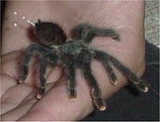
Pinktoe Tarantula
Encyclopedia
The pinktoe tarantula, Avicularia avicularia, is a species of tarantula
native to South America
, Costa Rica
to Brazil
, and the southern Caribbean
. This species is sometimes called the Guyana pinktoe, Common pinktoe or South American pinktoe since they are frequently harvested from those areas, and has pink feet pads.
The mature pinktoe tarantula has a dark-colored body and pinkish feet, in keeping with its name. Juvenile specimens, however, have pinkish bodies and dark-colored feet. Pinktoe tarantulas undergo a reversal in their coloration as they approach adulthood at 4-5 years.
These types of tarantulas are very docile, albeit nervous and jumpy, and are frequently kept as pets. Being arboreal species, they require a relatively tall habitat with plenty of climbing space. They require a lot of moisture, along with ample ventilation to prevent molds from developing.
Although this species is often rumoured to be communal, housing them in groups will almost inevitably lead to cannibalism over time.
Tarantula
Tarantulas comprise a group of often hairy and often very large arachnids belonging to the family Theraphosidae, of which approximately 900 species have been identified. Some members of the same Suborder may also be called "tarantulas" in the common parlance. This article will restrict itself to...
native to South America
South America
South America is a continent situated in the Western Hemisphere, mostly in the Southern Hemisphere, with a relatively small portion in the Northern Hemisphere. The continent is also considered a subcontinent of the Americas. It is bordered on the west by the Pacific Ocean and on the north and east...
, Costa Rica
Costa Rica
Costa Rica , officially the Republic of Costa Rica is a multilingual, multiethnic and multicultural country in Central America, bordered by Nicaragua to the north, Panama to the southeast, the Pacific Ocean to the west and the Caribbean Sea to the east....
to Brazil
Brazil
Brazil , officially the Federative Republic of Brazil , is the largest country in South America. It is the world's fifth largest country, both by geographical area and by population with over 192 million people...
, and the southern Caribbean
Caribbean
The Caribbean is a crescent-shaped group of islands more than 2,000 miles long separating the Gulf of Mexico and the Caribbean Sea, to the west and south, from the Atlantic Ocean, to the east and north...
. This species is sometimes called the Guyana pinktoe, Common pinktoe or South American pinktoe since they are frequently harvested from those areas, and has pink feet pads.
The mature pinktoe tarantula has a dark-colored body and pinkish feet, in keeping with its name. Juvenile specimens, however, have pinkish bodies and dark-colored feet. Pinktoe tarantulas undergo a reversal in their coloration as they approach adulthood at 4-5 years.
These types of tarantulas are very docile, albeit nervous and jumpy, and are frequently kept as pets. Being arboreal species, they require a relatively tall habitat with plenty of climbing space. They require a lot of moisture, along with ample ventilation to prevent molds from developing.
Although this species is often rumoured to be communal, housing them in groups will almost inevitably lead to cannibalism over time.

